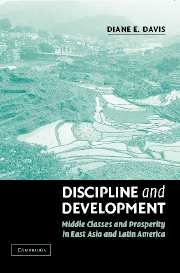Book contents
- Frontmatter
- Contents
- Preface
- DISCIPLINE AND DEVELOPMENT
- 1 An Introduction to Middle Classes, Discipline, and Development
- 2 Middle Classes and Development Theory
- 3 Discipline and Reward: Rural Middle Classes and the South Korean Development Miracle
- 4 Disciplinary Development as Rural Middle-Class Formation: Proletarianized Peasants and Farmer-Workers in Argentina and Taiwan
- 5 From Victors to Victims? Rural Middle Classes, Revolutionary Legacies, and the Unfulfilled Promise of Disciplinary Development in Mexico
- 6 Disciplinary Development in a New Millennium: The Global Context of Past Gains and Future Prospects
- Appendix A Cases, Comparisons, and a Note on Methodology and Sources
- Appendix B Defining the Middle Class: Notes on Boundaries and Epistemology
- Appendix C Tables
- Bibliography
- Index
2 - Middle Classes and Development Theory
Published online by Cambridge University Press: 31 July 2009
- Frontmatter
- Contents
- Preface
- DISCIPLINE AND DEVELOPMENT
- 1 An Introduction to Middle Classes, Discipline, and Development
- 2 Middle Classes and Development Theory
- 3 Discipline and Reward: Rural Middle Classes and the South Korean Development Miracle
- 4 Disciplinary Development as Rural Middle-Class Formation: Proletarianized Peasants and Farmer-Workers in Argentina and Taiwan
- 5 From Victors to Victims? Rural Middle Classes, Revolutionary Legacies, and the Unfulfilled Promise of Disciplinary Development in Mexico
- 6 Disciplinary Development in a New Millennium: The Global Context of Past Gains and Future Prospects
- Appendix A Cases, Comparisons, and a Note on Methodology and Sources
- Appendix B Defining the Middle Class: Notes on Boundaries and Epistemology
- Appendix C Tables
- Bibliography
- Index
Summary
Stalking the Path Not Taken
Forty years ago, long before the East Asian tigers roared loudly enough for the world to notice, it was unusual to find scholars who did not focus on middle classes in the study of development in the late-industrializing world. Today middle classes have practically vanished from the literature. In fact, most contemporary scholars of late industrialization focus on practically every social or class force but the middle class, while capitalists, laborers, and/or the state are invoked without pause. While rounding up the usual suspects year after year may not be inherently objectionable as an analytic strategy, it does raise epistemological questions about why middle classes disappeared from the development literature in the first place. Some no doubt would account for this state of affairs by linking the fate of middle classes to the rise and fall of modernization theory, a paradigm built around claims of a morally superior and generative role to be played by the middle classes. When modernization theory held sway in the field of development, middle classes danced on center stage; when modernization theory fell out of favor, replaced initially by dependency or world-system theory and then a variety of state-centered paradigms, middle classes swiftly exited the theoretical limelight.
The problem with emphasizing shifting theoretical paradigms, however, is that it tells little about why a concern with middle classes was not reformulated in terms more compatible with the theories that replaced modernization theory. This need not have been.
Information
- Type
- Chapter
- Information
- Discipline and DevelopmentMiddle Classes and Prosperity in East Asia and Latin America, pp. 26 - 63Publisher: Cambridge University PressPrint publication year: 2004
Accessibility standard: Unknown
- 1
- Cited by
